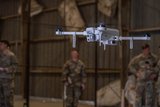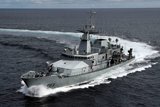US Defense Secretary Esper reiterates need for NATO nations to spend more
Mark Esper – the recently appointed US Defense Secretary – reiterated the US stance that its NATO allies should commit more to their defence expenditures during a press conference in London on 6 September.
Referring to the 2014 NATO Wales Summit, Esper spoke about the fact that only eight out of 29 NATO members are currently reaching the pledge to spend 2% of their total GDP on defence, at the halfway point of the 2024 deadline that was committed to in Wales.
During questioning at the event held at the Royal United Services Institute, Esper said, ‘The strength of our collective response requires that all alliance members be ready to do their part when called’, acknowledging that after President Trump’s push for NATO allies to spend more ‘in the next two years the hope is to see up to 17 countries reach the 2% mark’.
Esper went on to repeat the US stance on NATO: ‘The US is committed to NATO. The President has said that. But that means that NATO must be ready, we must live up to the expectations.'
he added that while the US may be committed to Article 5, which states that if a NATO ally is the victim of an armed attack, every NATO member will consider this as an armed attack against all other NATO members and take necessary action, everybody else needs to be committed to Article 3 in which NATO members will maintain and develop their individual and collective capacity to resist armed attack.
‘And when only eight countries are presently meeting 2%, and by the way to me 2% should be the floor, the defence spending should reflect the threats and the challenges we face. I would argue that the challenges and threats we face are much greater than 2%. The US is well over 3% at this point.’
Esper also spoke on the NATO readiness initiative that the US has put forward – the idea that ‘we would have 30 squadrons, 30 mechanised battalions and 30 naval combatants capable of being available within 30 days.
When asked about the need to prepare for future wars rather than past ones, a reference to Esper’s opening remarks and the fact that ‘The UK spending 2% means it can’t afford to build both its traditional forces and build new defences for new hybrid threats’, he stated that he believed the answer ‘has to be both’.
This is due to the evolution of warfare in to multi-domain operations. Esper said that ‘I believe the first shots of the next war will be in either cyber space or space...it won’t be a traditional volley of naval combatants. If we want to deter conflict, we need to be able to deter conflict across all of those domains.'
More from Defence Notes
-
![What will next-gen counter-UAS capabilities for the US look like?]()
What will next-gen counter-UAS capabilities for the US look like?
Future US counter-uncrewed aerial system solutions are likely to require a flexible, multi-layered approach to tackle a broad spectrum of new threats as they emerge.
-
![Elbit Systems awarded $2.3 billion contract as results soar]()
Elbit Systems awarded $2.3 billion contract as results soar
The company’s order backlog as of 30 September totalled $25.2 billion and more than a third of this is scheduled to be fulfilled before the end of 2026.
-
![US military foresees growing use of 3D printing]()
US military foresees growing use of 3D printing
Advanced manufacturing has evolved to meet military requirements and now supports multiple US critical assets, including Arleigh Burke-class destroyers, F-18, F-22, F-35, Bradley, HMMWV and Patriot.
-
![Irish Naval Service expands as the country looks to defence during EU presidency]()
Irish Naval Service expands as the country looks to defence during EU presidency
The Irish Naval Service has struggled to maintain capability, particularly in the face of lucrative private sector offers luring away personnel.
-
![Resilience, adaptiveness and collaboration vital for success in space (Studio)]()
Resilience, adaptiveness and collaboration vital for success in space (Studio)
Speakers at the Defence In Space Conference (DISC) 2025 highlighted the critical and evolving role of space in national security, defence and the global economy.

























